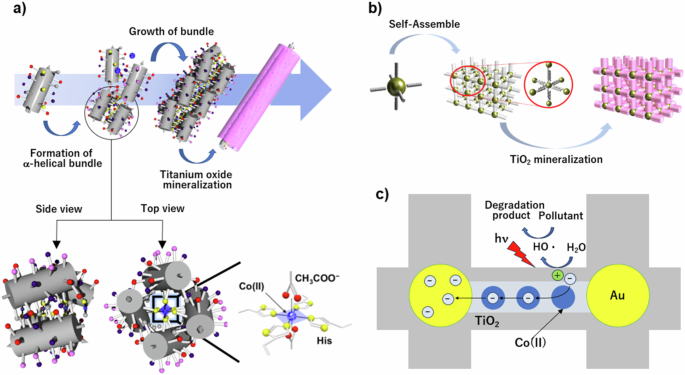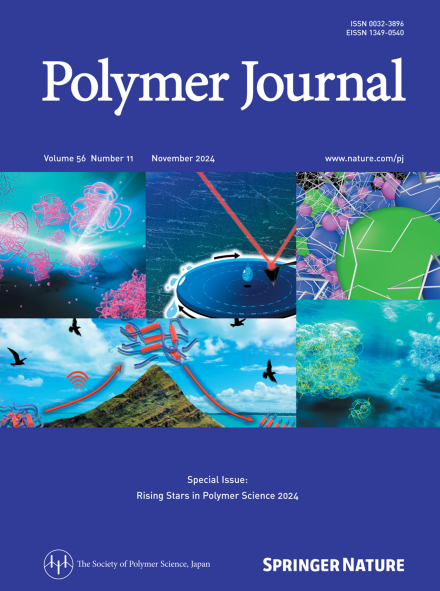Fabrication of a peptide–AuNP–TiO2 nanocomposite and its application as a VOC sensor
IF 2.3
4区 化学
Q3 POLYMER SCIENCE
引用次数: 0
Abstract
We fabricated a volatile organic compound (VOC) sensor with a peptide–Au nanoparticle (AuNP)–TiO2 nanocomposite in which AuNPs were linked with TiO2-coated conductive peptide nanowires. The conductive peptide nanowires were formed between the AuNPs via self-assembly through the complexation of amphiphilic peptides, LESEHEKLKSKHKSKLKEHESEL, and Co(II). Furthermore, TiO2 mineralization on the surface of the peptide nanowires yielded mixed crystals of rutile and anatase, which exhibited highly effective photolytic activity. In particular, the obtained TiO2 exhibited three times greater photodecomposition activity in the unsintered state toward organic matter than did commercially available TiO2. Next, we constructed a VOC sensor by immobilizing peptide–AuNP–TiO2 nanocomposites on a comb electrode. The electrochemical properties of the nanocomposite changed drastically under light irradiation in the presence of VOCs, indicating transport of the VOC-decomposition-generated photoexcited electrons of TiO2 to AuNPs through conductive peptide nanowires, which prevented electron–hole recombination. The obtained sensor exhibited a sensing range of 2–100 ppm for dichloromethane, which was used as a representative VOC. Therefore, nanocomposites made of AuNPs linked with conductive TiO2 nanotubes may be highly effective for TiO2-driven VOC decomposition. Moreover, we believe that this nanocomposite has high sensitivity for sensing VOCs. The peptide-Au nanoparticle (AuNP)-TiO2 nanocomposite in which AuNPs were connected by TiO2-coated conductive peptide nanowire was acted as effective VOC sensor.


多肽-AuNP-TiO2 纳米复合材料的制备及其在挥发性有机化合物传感器中的应用
我们用多肽-金纳米粒子(AuNP)-二氧化钛(TiO2)纳米复合材料制作了一种挥发性有机化合物(VOC)传感器。导电肽纳米线是通过两亲肽 LESEHEKLKSKHKSKLKEHESEL 和 Co(II)的复合物自组装在 AuNPs 之间形成的。此外,肽纳米线表面的 TiO2 矿化产生了金红石型和锐钛矿型混合晶体,表现出高效的光解活性。特别是,所获得的二氧化钛在未烧结状态下对有机物的光分解活性是市售二氧化钛的三倍。接着,我们将肽-AuNP-TiO2 纳米复合材料固定在梳状电极上,构建了一种挥发性有机化合物传感器。在有挥发性有机化合物存在的情况下,纳米复合材料在光照射下的电化学特性发生了急剧变化,这表明挥发性有机化合物分解产生的光激发电子通过导电肽纳米线传输到金纳米粒子上,从而阻止了电子-空穴重组。所获得的传感器对具有代表性的挥发性有机化合物二氯甲烷的感应范围为 2-100 ppm。因此,由 AuNPs 与导电 TiO2 纳米管连接而成的纳米复合材料可能对 TiO2 驱动的挥发性有机化合物分解非常有效。此外,我们还认为这种纳米复合材料具有很高的 VOC 检测灵敏度。
本文章由计算机程序翻译,如有差异,请以英文原文为准。
求助全文
约1分钟内获得全文
求助全文
来源期刊

Polymer Journal
化学-高分子科学
CiteScore
5.60
自引率
7.10%
发文量
131
审稿时长
2.5 months
期刊介绍:
Polymer Journal promotes research from all aspects of polymer science from anywhere in the world and aims to provide an integrated platform for scientific communication that assists the advancement of polymer science and related fields. The journal publishes Original Articles, Notes, Short Communications and Reviews.
Subject areas and topics of particular interest within the journal''s scope include, but are not limited to, those listed below:
Polymer synthesis and reactions
Polymer structures
Physical properties of polymers
Polymer surface and interfaces
Functional polymers
Supramolecular polymers
Self-assembled materials
Biopolymers and bio-related polymer materials
Polymer engineering.
 求助内容:
求助内容: 应助结果提醒方式:
应助结果提醒方式:


